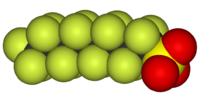
Photo from wikipedia
Untargeted liquid chromatographic-high-resolution mass spectrometric (LC-HRMS) metabolomics for potential exposure marker (PEM) discovery in nutrikinetic studies generates complex outputs. The correct selection of statistically significant PEMs is a crucial analytical… Click to show full abstract
Untargeted liquid chromatographic-high-resolution mass spectrometric (LC-HRMS) metabolomics for potential exposure marker (PEM) discovery in nutrikinetic studies generates complex outputs. The correct selection of statistically significant PEMs is a crucial analytical step for understanding nutrition-health interactions. Hence, in this paper, different chemometric selection workflows for PEM discovery, using multivariate or univariate parametric or non-parametric data analyses, were comparatively tested and evaluated. The PEM selection protocols were applied to a small-sample-size untargeted LC-HRMS study of a longitudinal set of serum samples from 20 volunteers after a single intake of (poly)phenolic-rich Vaccinium myrtillus and Vaccinium corymbosum supplements. The non-parametric Games-Howell test identified a restricted group of significant features, thus minimizing the risk of false-positive retention. Among the forty-seven PEMs exhibiting a statistically significant postprandial kinetics, twelve were successfully annotated as purine pathway metabolites, benzoic and benzodiol metabolites, indole alkaloids, and organic and fatty acids, and five (i.e. octahydro-methyl-β-carboline-dicarboxylic acid, tetrahydro-methyl-β-carboline-dicarboxylic acid, citric acid, caprylic acid, and azelaic acid) were associated to Vaccinium berry consumption for the first time. The analysis of the area under the curve of the longitudinal dataset highlighted thirteen statistically significant PEMs discriminating the two interventions, including four intra-intervention relevant metabolites (i.e. abscisic acid glucuronide, catechol sulphate, methyl-catechol sulphate, and α-hydroxy-hippuric acid). Principal component analysis and sample classification through linear discriminant analysis performed on PEM maximum intensity confirmed the discriminating role of these PEMs.
Journal Title: Analytical and Bioanalytical Chemistry
Year Published: 2022
Link to full text (if available)
Share on Social Media: Sign Up to like & get
recommendations!